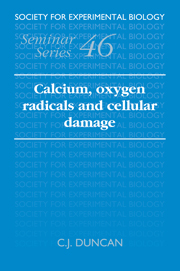Book contents
- Frontmatter
- Contents
- List of Contributors
- Preface
- 1 Are there common biochemical pathways in cell damage and cell death?
- 2 Free radicals in the pathogenesis of tissue damage
- 3 Calcium and signal transduction in oxidative cell damage
- 4 Regulation of neutrophil oxidant production
- 5 Reperfusion arrhythmias: role of oxidant stress
- 6 Biochemical pathways that lead to the release of cytosolic proteins in the perfused rat heart
- 7 Malignant hyperthermia: the roles of free radicals and calcium?
- 8 Free radicals, calcium and damage in dystrophic and normal skeletal muscle
- 9 Ultrastructural changes in mitochondria during rapid damage triggered by calcium
- 10 The importance of oxygen free radicals, iron and calcium in renal ischaemia
- 11 The Rubicon Hypothesis: a quantal framework for understanding the molecular pathway of cell activation and injury
- Index
4 - Regulation of neutrophil oxidant production
Published online by Cambridge University Press: 18 January 2010
- Frontmatter
- Contents
- List of Contributors
- Preface
- 1 Are there common biochemical pathways in cell damage and cell death?
- 2 Free radicals in the pathogenesis of tissue damage
- 3 Calcium and signal transduction in oxidative cell damage
- 4 Regulation of neutrophil oxidant production
- 5 Reperfusion arrhythmias: role of oxidant stress
- 6 Biochemical pathways that lead to the release of cytosolic proteins in the perfused rat heart
- 7 Malignant hyperthermia: the roles of free radicals and calcium?
- 8 Free radicals, calcium and damage in dystrophic and normal skeletal muscle
- 9 Ultrastructural changes in mitochondria during rapid damage triggered by calcium
- 10 The importance of oxygen free radicals, iron and calcium in renal ischaemia
- 11 The Rubicon Hypothesis: a quantal framework for understanding the molecular pathway of cell activation and injury
- Index
Summary
Polymorphonuclear leukocytes (neutrophils) provide the first line of defence to protect the host against most bacterial and many fungal pathogens, and hence possess an array of specialised cytotoxic processes and associated pathways in order to perform this important function during phagocytosis. In the 1930s the importance of O2 was recognised when it was discovered (Baldridge & Gerard, 1933) that a ‘respiratory burst’ accompanied phagocytosis, but this was mistakenly believed to be due to increased mitochondrial respiration necessary to supply the extra energy required for phagocytosis. The unusual nature of the respiratory burst was not appreciated until later (Sbarra & Karnovsky, 1959) when it was found to be uninhibited by cyanide and hence not associated with mitochondrial respiration. Later, it was proposed that H2O2 was generated during phagocytosis (Iyer, Islam & Quastel, 1961) and that O2− was the primary product of O2 reduction (Babior, Kipnes & Curnutte, 1973). It was therefore suggested that the respiratory burst was required for the generation of oxygen metabolites which were instrumental in pathogen killing (Selvaraj & Sbarra, 1966). The link between the products of the burst and microbial killing was confirmed when it was discovered that phagocytes from patients with chronic granulomatous disease (CGD, formerly Fatal Granulomatous Disease of Childhood) who are predisposed to life-threatening infections had an impaired ability of their phagocytes to mount a respiratory burst (Holmes, Page & Good, 1967). The search for the molecular defects responsible for this condition (or group of related conditions) has proved invaluable in identifying the molecular components required for oxidant generation (Segal, 1989a,b), and also in elucidating the complex processes by which these become assembled and activated during phagocytosis.
- Type
- Chapter
- Information
- Calcium, Oxygen Radicals and Cellular Damage , pp. 35 - 76Publisher: Cambridge University PressPrint publication year: 1991
- 8
- Cited by



